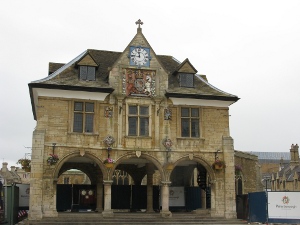 A most impressive front
often occupy land which was earlier occupied by other religious structures, from Saxon churches to Benedictine monasteries, and that the land itself could be unstable, requiring building and rebuilding and rebuilding.
A most impressive front
often occupy land which was earlier occupied by other religious structures, from Saxon churches to Benedictine monasteries, and that the land itself could be unstable, requiring building and rebuilding and rebuilding.
Which was our favorite cathedral? We have learned to look up to the ceilings, to identify Perpendicular, Romanesque, Gothic and Norman architecture, to examine the floors. We have learned that cathedrals were normally built from east to west (e.g., Ely). We understand that they  A most impressive front
often occupy land which was earlier occupied by other religious structures, from Saxon churches to Benedictine monasteries, and that the land itself could be unstable, requiring building and rebuilding and rebuilding.
A most impressive front
often occupy land which was earlier occupied by other religious structures, from Saxon churches to Benedictine monasteries, and that the land itself could be unstable, requiring building and rebuilding and rebuilding.
Our train to Peterborough (via Ely) got off to a interrupted start. We pulled out of the Norwich station, got to the end of town, stopped, reversed and then went a short way back towards Norwich. Announcement on the train's public address system: the signals had not been properly set. We had been on our way to London instead of to Cambridge. We'd start again when the signals were corrected. And so we did.
At the Peterborough station we found a large direction post, with signs pointing to the railroad museum, the city museum, the cathedral, and downtown shops. All but the railroad museum were in the same direction, so we walked along, passing beneath the main road through an underpass gaily decorated by schoolchildren. We would continue to find contrasts between very old and very recent life in this city.
 The ceiling reflected in a mirror
The ceiling reflected in a mirror
We first walked through the town center, distracted by the temporary fences of major construction sites. It turned out that the building being renovated was the Guildhall, originally completed in 1670 and restored several times since then. This Sunday morning was cloudy but pleasant after an early morning rain, so the shopping streets were filled with families windowshopping or chatting with friends.
We spent most our time in the Peterborough Cathedral. Completed in 1238, it was named Cathedral in 1541 by Henry VIII, who apparently preserved it at a time when other cathedrals were being destroyed because his first wife, Catherine of Aragon, is buried here (it also temporarily held the body of Mary, Queen of Scots, which was later removed and reburied in Westminster Abbey, by order of her son, James I). The cathedral has  The guildhall under restoration
been carefully maintained in modern times. We asked about war damage and were told that the major war damage occurred during the Civil Wars, when soldiers were billetted in the cathedral and become rowdy.
The guildhall under restoration
been carefully maintained in modern times. We asked about war damage and were told that the major war damage occurred during the Civil Wars, when soldiers were billetted in the cathedral and become rowdy.
The wooden ceilling is the oldest in England still in place. Historical exhibits help to explain the religious conventions of different periods. It was a comfortable and educational place, just right for a rainy Sunday. Travelling in England was a form of time travel for us, coming from a country whose recorded history runs out 500 years ago, and a country with very few buildings more than 200 years old.
Leaving the cathedral, we found a concert about to start at the Guildhall, where a group of young people played for a small audience of passersby. When it started to shower again, we headed for the Queensgate shopping mall and found probably the largest mall we've be in during our visit. Our exit led us directly to a covered bridge over the busy road and ending at the edge of the railroad station. Couldn't be better.